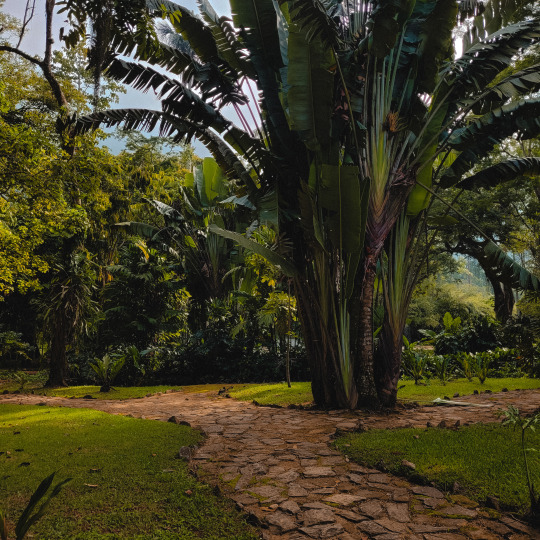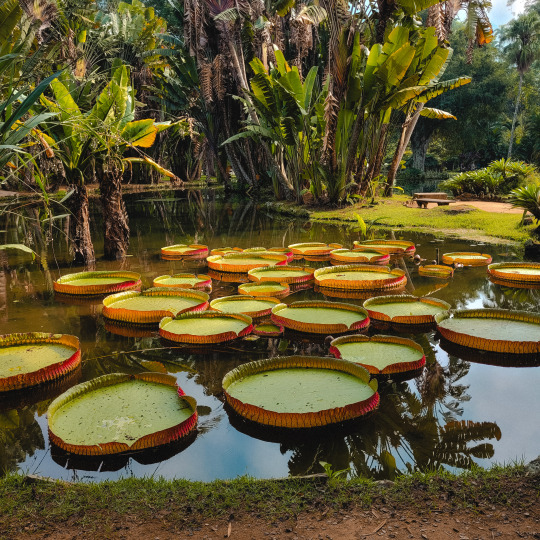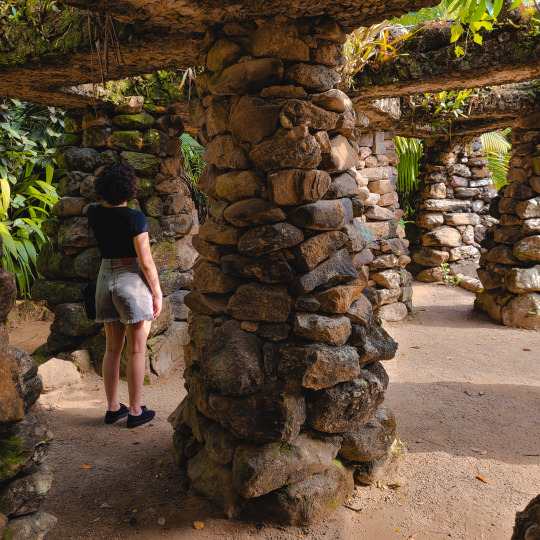#plants of brazil
Explore tagged Tumblr posts
Text

When you think of a bromeliad, you probably don't think of something that looks like this. Bromeliads of the genus Sincoraea are among some of the strangest that I've ever seen. Almost all are endemic to Bahia, Brazil, where this one was found (one lives in Minas Gerais), mostly from the campo rupestre habitat. They remind me of sea anemones or starfish on the rocks!
244 notes
·
View notes
Text
"With “green corridors” that mimic the natural forest, the Colombian city is driving down temperatures — and could become five degrees cooler over the next few decades.
In the face of a rapidly heating planet, the City of Eternal Spring — nicknamed so thanks to its year-round temperate climate — has found a way to keep its cool.
Previously, Medellín had undergone years of rapid urban expansion, which led to a severe urban heat island effect — raising temperatures in the city to significantly higher than in the surrounding suburban and rural areas. Roads and other concrete infrastructure absorb and maintain the sun’s heat for much longer than green infrastructure.
“Medellín grew at the expense of green spaces and vegetation,” says Pilar Vargas, a forest engineer working for City Hall. “We built and built and built. There wasn’t a lot of thought about the impact on the climate. It became obvious that had to change.”
Efforts began in 2016 under Medellín’s then mayor, Federico Gutiérrez (who, after completing one term in 2019, was re-elected at the end of 2023). The city launched a new approach to its urban development — one that focused on people and plants.
The $16.3 million initiative led to the creation of 30 Green Corridors along the city’s roads and waterways, improving or producing more than 70 hectares of green space, which includes 20 kilometers of shaded routes with cycle lanes and pedestrian paths.
These plant and tree-filled spaces — which connect all sorts of green areas such as the curb strips, squares, parks, vertical gardens, sidewalks, and even some of the seven hills that surround the city — produce fresh, cooling air in the face of urban heat. The corridors are also designed to mimic a natural forest with levels of low, medium and high plants, including native and tropical plants, bamboo grasses and palm trees.
Heat-trapping infrastructure like metro stations and bridges has also been greened as part of the project and government buildings have been adorned with green roofs and vertical gardens to beat the heat. The first of those was installed at Medellín’s City Hall, where nearly 100,000 plants and 12 species span the 1,810 square meter surface.
“It’s like urban acupuncture,” says Paula Zapata, advisor for Medellín at C40 Cities, a global network of about 100 of the world’s leading mayors. “The city is making these small interventions that together act to make a big impact.”
At the launch of the project, 120,000 individual plants and 12,500 trees were added to roads and parks across the city. By 2021, the figure had reached 2.5 million plants and 880,000 trees. Each has been carefully chosen to maximize their impact.
“The technical team thought a lot about the species used. They selected endemic ones that have a functional use,” explains Zapata.
The 72 species of plants and trees selected provide food for wildlife, help biodiversity to spread and fight air pollution. A study, for example, identified Mangifera indica as the best among six plant species found in Medellín at absorbing PM2.5 pollution — particulate matter that can cause asthma, bronchitis and heart disease — and surviving in polluted areas due to its “biochemical and biological mechanisms.”
And the urban planting continues to this day.
The groundwork is carried out by 150 citizen-gardeners like Pineda, who come from disadvantaged and minority backgrounds, with the support of 15 specialized forest engineers. Pineda is now the leader of a team of seven other gardeners who attend to corridors all across the city, shifting depending on the current priorities...
“I’m completely in favor of the corridors,” says [Victoria Perez, another citizen-gardener], who grew up in a poor suburb in the city of 2.5 million people. “It really improves the quality of life here.”
Wilmar Jesus, a 48-year-old Afro-Colombian farmer on his first day of the job, is pleased about the project’s possibilities for his own future. “I want to learn more and become better,” he says. “This gives me the opportunity to advance myself.”
The project’s wider impacts are like a breath of fresh air. Medellín’s temperatures fell by 2°C in the first three years of the program, and officials expect a further decrease of 4 to 5C over the next few decades, even taking into account climate change. In turn, City Hall says this will minimize the need for energy-intensive air conditioning...
In addition, the project has had a significant impact on air pollution. Between 2016 and 2019, the level of PM2.5 fell significantly, and in turn the city’s morbidity rate from acute respiratory infections decreased from 159.8 to 95.3 per 1,000 people [Note: That means the city's rate of people getting sick with lung/throat/respiratory infections.]
There’s also been a 34.6 percent rise in cycling in the city, likely due to the new bike paths built for the project, and biodiversity studies show that wildlife is coming back — one sample of five Green Corridors identified 30 different species of butterfly.
Other cities are already taking note. Bogotá and Barranquilla have adopted similar plans, among other Colombian cities, and last year São Paulo, Brazil, the largest city in South America, began expanding its corridors after launching them in 2022.
“For sure, Green Corridors could work in many other places,” says Zapata."
-via Reasons to Be Cheerful, March 4, 2024
#colombia#brazil#urban#urban landscape#urban planning#cities#civil engineering#green architecture#green spaces#urban heat#urban heat island effect#weather#meteorology#global warming#climate change#climate hope#climate optimism#climate emergency#climate action#environment#environmental news#city architecture#bicycling#native plants#biodiversity#good news#hope#solarpunk#ecopunk#hopepunk
18K notes
·
View notes
Text






02/15/2008 vivo rio rio de janeiro brazil meet with fans
#frank talk to plant#2008 mcr brazil#mcrmy brazil#my chemical romance#mcr#gerard way#frank iero#mikey way#ray toro#brazil#2008#black parade era#black parade is dead era#shows#fan pictures
116 notes
·
View notes
Text
Scientists have discovered cannabidiol, a compound in cannabis known as CBD, in a common Brazilian plant, opening potential new avenues to produce the increasingly popular substance. The team found CBD in the fruits and flowers of a plant known as Trema micrantha blume, a shrub which grows across much of the South American country and is often considered a weed, molecular biologist Rodrigo Moura Neto of the Federal University of Rio de Janeiro told AFP in June 2023. CBD, increasingly used by some to treat conditions including epilepsy, chronic pain and anxiety, is one of the main active compounds in cannabis, along with tetrahydrocannabinol, or THC – the substance that makes users feel high. The compound's effectiveness as a medical treatment is still under research.
Continue Reading.
#Science#Plants#Health#Biology#Molecular Biology#Cannabis#CBD#Cannabidoil#Trema Micrantha Blume#Brazil
278 notes
·
View notes
Text

look what I found 🌱
#cats#cats of tumblr#cute cats#my cats#funny cats#catsoftheworld#catsofinstagram#art#animals#cute animals#cute#cutecore#so cute#lovely moots 💕#plants#green#painting#beautiful photos#photography#brazil#pernambuco#rain wolrd#❤️🩹#🥺#😭#baby#wlw post#orange cat
54 notes
·
View notes
Text




pretty pictures taken by @sightlyhigh at the Botanical Garden of Rio de Janeiro
#sightlyhigh#burntpink#mine#nature#rio de janeiro#jardim botânico#botanical garden#plants#brasil#brazil#botanic garden#botany#tropical#tropical flora#tropical forest#rainforest#lily pads#lily pad#brasilcore#brazilcore
667 notes
·
View notes
Text

“Pandora”
This panorama shows the beauty of Chapada dos Veadeiros, a Brazilian national park that hosts a rich biodiversity and breathtaking landscapes. The white flowers that stand out in the foreground are a rare species of Paepalanthus, a genus of plants endemic to the region. They were illuminated by a scurion lamp to create a contrast with the dark sky.
by Marcio Cabral.
Nature Photography Contest
#marcio cabral#photographer#nature photography contest#chapada dos veadeiros#brazilian national park#brazil#paepalanthus#flowers#milky way#starry night#night photography#nature#plants
71 notes
·
View notes
Text

Iguazu Falls
1K notes
·
View notes
Text


When the pink ipê blooms, it is as if nature presents us with a spectacle of colors...🌺✨

#jonathan blossom#iperosa#ipe#pink flowers#brazilian nature#brazilian beauty#brazil#flowers#plants#beautiful photos#phtography#nature photography#jon★th☆n#nature#spring flowers#fotos tumblr#my photos#original photography on tumblr#artists on tumblr#presidente prudente
69 notes
·
View notes
Text

Sinimbu, Brasil, 26 Janeiro 2025
#Plantas#Photographers on tumblr#Photography#Plants#Pflanzen#Fotografie#fotografia#Photographie#original photograph#Sinimbu#Brazil#Brasil
24 notes
·
View notes
Text

The classic
#brazil#brasil#são paulo#fotografia#photo#photography#love#artists on tumblr#sp#tumblr#flor#flower#rose#pink#plants#garden#nature#rain#chuva#amor#beautiful#cute#rosa#high quality#art#artes#fofo#she#her#present
21 notes
·
View notes
Text

Tradescantia zebrina
#she survived a thrip infestation 👏#got hit with thrips in the spring on this gal and my philo brazil. and my cannabis >:(#so i took cuttings of the first 2 and sprayed them very thoroughly with deadbug brew and put em in a bag for like a few weeks#then rerooted them and have not seen any thrips since<3#both plants used to be Massive but i decided to play it safe and just take cuttinfs and throw the rest out. rip#now with the cannabis. it took months to get rid of those mfers#plant#plants#plantblr#succulent#succulents#succulentblr#tradescantia#tradescantia zebrina#inchplant#spiderwort#mine#houseplants#horticulture#botany
194 notes
·
View notes
Text
Masterpost: Reasons I firmly believe we will beat climate change
Posts are in reverse chronological order (by post date, not article date), mostly taken from my "climate change" tag, which I went through all the way back to the literal beginning of my blog. Will update periodically.
Especially big deal articles/posts are in bold.
Big picture:
Mature trees offer hope in world of rising emissions (x)
Spying from space: How satellites can help identify and rein in a potent climate pollutant (x)
Good news: Tiny urban green spaces can cool cities and save lives (x)
Conservation and economic development go hand in hand, more often than expected (x)
The exponential growth of solar power will change the world (x)
Sun Machines: Solar, an energy that gets cheaper and cheaper, is going to be huge (x)
Wealthy nations finally deliver promised climate aid, as calls for more equitable funding for poor countries grow (x)
For Earth Day 2024, experts are spreading optimism – not doom. Here's why. (x)
Opinion: I’m a Climate Scientist. I’m Not Screaming Into the Void Anymore. (x)
The World’s Forests Are Doing Much Better Than We Think (x)
‘Staggering’ green growth gives hope for 1.5C, says global energy chief (x)
Beyond Catastrophe: A New Climate Reality Is Coming Into View (x)
Young Forests Capture Carbon Quicker than Previously Thought (x)
Yes, climate change can be beaten by 2050. Here's how. (x)
Soil improvements could keep planet within 1.5C heating target, research shows (x)
The global treaty to save the ozone layer has also slowed Arctic ice melt (x)
The doomers are wrong about humanity’s future — and its past (x)
Scientists Find Methane is Actually Offsetting 30% of its Own Heating Effect on Planet (x)
Are debt-for-climate swaps finally taking off? (x)
High seas treaty: historic deal to protect international waters finally reached at UN (x)
How Could Positive ‘Tipping Points’ Accelerate Climate Action? (x)
Specific examples:
Environmental Campaigners Celebrate As Labour Ends Tory Ban On New Onshore Wind Projects (x)
Private firms are driving a revolution in solar power in Africa (x)
How the small Pacific island nation of Vanuatu drastically cut plastic pollution (x)
Rewilding sites have seen 400% increase in jobs since 2008, research finds [Scotland] (x)
The American Climate Corps take flight, with most jobs based in the West (x)
Waste Heat Generated from Electronics to Warm Finnish City in Winter Thanks to Groundbreaking Thermal Energy Project (x)
Climate protection is now a human right — and lawsuits will follow [European Union] (x)
A new EU ecocide law ‘marks the end of impunity for environmental criminals’ (x)
Solar hits a renewable energy milestone not seen since WWII [United States] (x)
These are the climate grannies. They’ll do whatever it takes to protect their grandchildren. [United States and Native American Nations] (x)
Century of Tree Planting Stalls the Warming Effects in the Eastern United States, Says Study (x)
Chart: Wind and solar are closing in on fossil fuels in the EU (x)
UK use of gas and coal for electricity at lowest since 1957, figures show (x)
Countries That Generate 100% Renewable Energy Electricity (x)
Indigenous advocacy leads to largest dam removal project in US history [United States and Native American Nations] (x)
India’s clean energy transition is rapidly underway, benefiting the entire world (x)
China is set to shatter its wind and solar target five years early, new report finds (x)
‘Game changing’: spate of US lawsuits calls big oil to account for climate crisis (x)
Largest-ever data set collection shows how coral reefs can survive climate change (x)
The Biggest Climate Bill of Your Life - But What Does It DO? [United States] (x)
Good Climate News: Headline Roundup April 1st through April 15th, 2023 (x)
How agroforestry can restore degraded lands and provide income in the Amazon (x) [Brazil]
Loss of Climate-Crucial Mangrove Forests Has Slowed to Near-Negligable Amount Worldwide, Report Hails (x)
Agroecology schools help communities restore degraded land in Guatemala (x)
Climate adaptation:
Solar-powered generators pull clean drinking water 'from thin air,' aiding communities in need: 'It transforms lives' (x)
‘Sponge’ Cities Combat Urban Flooding by Letting Nature Do the Work [China] (x)
Indian Engineers Tackle Water Shortages with Star Wars Tech in Kerala (x)
A green roof or rooftop solar? You can combine them in a biosolar roof — boosting both biodiversity and power output (x)
Global death tolls from natural disasters have actually plummeted over the last century (x)
Los Angeles Just Proved How Spongy a City Can Be (x)
This city turns sewage into drinking water in 24 hours. The concept is catching on [Namibia] (x)
Plants teach their offspring how to adapt to climate change, scientists find (x)
Resurrecting Climate-Resilient Rice in India (x)
Edit 1/12/25: Yes, I know a bunch of the links disappeared. I'll try to fix that when I get the chance. In the meantime, read all the other stuff!!
Other Masterposts:
Going carbon negative and how we're going to fix global heating (x)
#climate change#climate crisis#climate action#climate emergency#climate anxiety#climate solutions#fossil fuels#pollution#carbon emissions#solar power#wind power#trees#forests#tree planting#biodiversity#natural disasters#renewables#renewable electricity#united states#china#india#indigenous nations#european union#plant biology#brazil#uk#vanuatu#scotland#england#methane
2K notes
·
View notes
Text


Roberto Burle Marx
#Roberto Burle Marx#burle marx#brazil#brasil#architecture#art#botanist#botanic garden#plants#Brazil art#arte brasileira#arquitetura#paisagismo#garden
28 notes
·
View notes
Text

Two nuclear plants (father Manuel Alcântara), São Paulo, Brazil, ca. 1980 - by Araquém Alcântara (1951), Brazilian
76 notes
·
View notes
Text

I want to find the path to happiness.
#art#nature#natureza#flowers#plants#terra talks#explore#green#film#film photography#filmedit#my pics#panty pics#sky#photoblog#photography#beautiful photos#photoshoot#photo#urban photography#brazil#brasil#pernambuco#yellow aesthetic#arsthetic#aesthetic#jungle#cottagecore#cottage aesthetic
25 notes
·
View notes